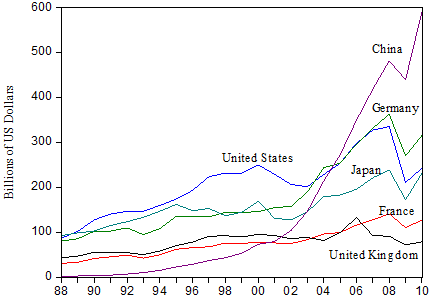| Author Name | THORBECKE, Willem (Senior Fellow, RIETI) |
|---|---|
| Research Project | East Asian Production Networks and Global Imbalances |
| Download / Links |
This Non Technical Summary does not constitute part of the above-captioned Discussion Paper but has been prepared for the purpose of providing a bold outline of the paper, based on findings from the analysis for the paper and focusing primarily on their implications for policy. For details of the analysis, read the captioned Discussion Paper. Views expressed in this Non Technical Summary are solely those of the individual author(s), and do not necessarily represent the views of the Research Institute of Economy, Trade and Industry (RIETI).
International Macroeconomics Program (FY2011-FY2015)
East Asian Production Network and Global Imbalances Project
Capital goods exports exceed $3 trillion and are volatile. The majority of these exports over the last 20 years have come from China, France, Germany, Japan, the UK, and the United States. Figure 1 shows the value of capital and equipment goods exports from these exporters. The United States was the largest exporter until 2003, but was then overtaken by Germany and China. The figure also shows that exports fell the most for the United States after the global financial crisis in 2008. Logarithmically, U.S. capital goods exports fell by 46% between 2008 and 2009. The second largest percentage drop was for Japan. Its exports fell 33% between 2008 and 2009.
To try to understand movements in capital goods exports, this paper estimates trade elasticities. For the UK and the United States, exports depend on exchange rates. For Germany and France, they do not. For Japan, exports to non-Asian countries depend on exchange rates and exports to Asian countries depend on Asia's exports to the rest of the world. For all countries, capital exports depend on GDP in the importing countries.
Since capital exports depend on income in importing countries, it is informative to know where the exports go. Table 1 presents this information. France, Germany, and the UK are most dependent on the eurozone. China and the United States are more dependent on NAFTA countries. Japan, being upstream in regional supply chains, sends 46% of its capital goods exports to East Asia.
The results in the paper imply that U.S. exports tumbled in 2009 because the dollar appreciated and global growth slowed. They also indicate that Japanese exports crashed because of the perfect storm of a yen appreciation, a global slowdown, and a collapse in Asia's exports. The massive appreciations of the dollar and the yen between 2008 and 2009 thus contributed to the collapse of U.S. and Japanese capital goods exports. Monetary authorities should consider how to limit exchange rate overshooting when it has such pernicious effects.
Figure 1
The value of capital and equipment goods exports from major exporting countries to the world.

Source: CEPII-Chelem Database
|
Exporting Country or Region |
Importing | Region | ||
| East Asia | Euroland | NAFTA | Rest of World | |
| China | 18.0% | 17.2% | 28.9% | 35.9% |
|
East Asia Ex-Japan |
25.2% | 15.4% | 25.4% | 34.0% |
| France | 10.5% | 38.8% | 11.1% | 39.5% |
| Germany | 14.0% | 32.5% | 9.5% | 44.0% |
| Japan | 45.8% | 10.0% | 17.0% | 27.1% |
| United Kingdom | 9.3% | 37.8% | 17.2% | 35.6% |
| United States | 24.1% | 15.8% | 26.8% | 33.3% |
Source: CEPII-CHELEM database.
Notes: East Asia includes China, Japan, Malaysia, the Philippines, Singapore, South Korea, Taiwan, and Thailand. The Euroland includes all countries that use the euro as its currency. NAFTA includes, Canada, Mexico, and the United States.

